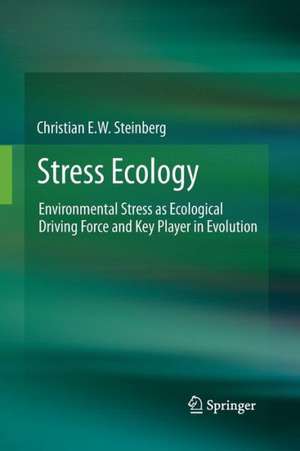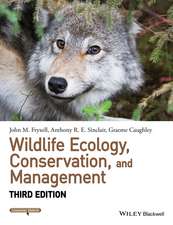Stress Ecology: Environmental Stress as Ecological Driving Force and Key Player in Evolution
Autor Christian E.W. Steinbergen Limba Engleză Paperback – 28 noi 2014
The book describes the general stress responses in microorganisms, plants, and animals to abiotic and biotic, to natural and anthropogenic stressors. These stress responses include the activation of oxygen, the biotransformation system, the stress proteins, and the metal-binding proteins. The potential of stress response lies in the transcription of genes, whereas the actual response is manifested by proteins and metabolites. Yet, not all stress responses are in the genes: micro-RNAs and epigenetics play central roles. Multiple stressors, such as environmental realism, do not always act additively; they may even diminish one another. Furthermore, one stressor often prepares the subject for the next one to come and may produce extended lifespans and increased offspring numbers, thus causing shifts in population structures.
This book provides the first comprehensive analysis of the ecological and evolutionary effects of stress.
| Toate formatele și edițiile | Preț | Express |
|---|---|---|
| Paperback (1) | 953.82 lei 6-8 săpt. | |
| SPRINGER NETHERLANDS – 28 noi 2014 | 953.82 lei 6-8 săpt. | |
| Hardback (1) | 805.40 lei 38-44 zile | |
| SPRINGER NETHERLANDS – 10 sep 2011 | 805.40 lei 38-44 zile |
Preț: 953.82 lei
Preț vechi: 1163.20 lei
-18% Nou
Puncte Express: 1431
Preț estimativ în valută:
182.53€ • 198.21$ • 153.33£
182.53€ • 198.21$ • 153.33£
Carte tipărită la comandă
Livrare economică 22 aprilie-06 mai
Preluare comenzi: 021 569.72.76
Specificații
ISBN-13: 9789400798977
ISBN-10: 9400798970
Pagini: 492
Ilustrații: XII, 480 p.
Dimensiuni: 155 x 235 x 26 mm
Greutate: 0.69 kg
Ediția:2012
Editura: SPRINGER NETHERLANDS
Colecția Springer
Locul publicării:Dordrecht, Netherlands
ISBN-10: 9400798970
Pagini: 492
Ilustrații: XII, 480 p.
Dimensiuni: 155 x 235 x 26 mm
Greutate: 0.69 kg
Ediția:2012
Editura: SPRINGER NETHERLANDS
Colecția Springer
Locul publicării:Dordrecht, Netherlands
Public țintă
ResearchCuprins
Why a small worm is not crazy (Introduction).-Activation of oxygen: Multipurpose tool.-Defense means against pathogens and parasites: Reactive oxygen species.- Arms race between plants and animals: Biotransformation system.- Heat shock proteins: The minimal, but universal, stress proteome.- Heavy metals: Defense and ecological utilization.- The potential of stress response: Ecological transcriptomics.- Not all is in the genes: microRNAs, transgenerational effects, and epigenetics.- The actual response: Ecological proteomics and metabolomics.- Whatever doesn’t kill you might make you stronger: Hormesis.- Multiple stressors as environmental realism: Synergism or antagonism.- One stressor prepares for the next one to come: Cross-tolerance.-Longevity: Risky shift in population structure?.- Footprints of stress in communities.-Environmental stresses: Ecological driving forces and key player in evolution.-References.-Appendices,-Abbreviations and Glossary,-Index.
Textul de pe ultima copertă
Not all stress is stressful; instead, it appears that stress in the environment, below the mutation threshold, is essential for many subtle manifestations of population structures and biodiversity, and has played a substantial role in the evolution of life. Intrigued by the behavior of laboratory animals that contradicted our current understanding of stress, the author and his group studied the beneficial effects of stress on animals and plants. The seemingly “crazy” animals demonstrated that several stress paradigms are outdated and have to be reconsidered.
The book describes the general stress responses in microorganisms, plants, and animals to abiotic and biotic, to natural and anthropogenic stressors. These stress responses include the activation of oxygen, the biotransformation system, the stress proteins, and the metal-binding proteins. The potential of stress response lies in the transcription of genes, whereas the actual response is manifested by proteins and metabolites. Yet, not all stress responses are in the genes: micro-RNAs and epigenetics play central roles. Multiple stressors, such as environmental realism, do not always act additively; they may even diminish one another. Furthermore, one stressor often prepares the subject for the next one to come and may produce extended lifespans and increased offspring numbers, thus causing shifts in population structures.
This book provides the first comprehensive analysis of the ecological and evolutionary effects of stress.
The book describes the general stress responses in microorganisms, plants, and animals to abiotic and biotic, to natural and anthropogenic stressors. These stress responses include the activation of oxygen, the biotransformation system, the stress proteins, and the metal-binding proteins. The potential of stress response lies in the transcription of genes, whereas the actual response is manifested by proteins and metabolites. Yet, not all stress responses are in the genes: micro-RNAs and epigenetics play central roles. Multiple stressors, such as environmental realism, do not always act additively; they may even diminish one another. Furthermore, one stressor often prepares the subject for the next one to come and may produce extended lifespans and increased offspring numbers, thus causing shifts in population structures.
This book provides the first comprehensive analysis of the ecological and evolutionary effects of stress.
Caracteristici
First comprehensive synopsis on the ecological and evolutionary effects of stress Establishes stresses as essential ecological driving forces and evolutionary triggers First comprehensive synopsis on stress response pathways in microorganisms, plants, animals, and ecosystems










